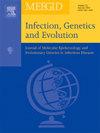Taxonomic reassessment of genomes from a divergent population of Streptococcus suis by average nucleotide identity analysis
IF 2.6
4区 医学
Q3 INFECTIOUS DISEASES
引用次数: 0
Abstract
Streptococcus spp., including the emerging zoonotic pathogen S. suis, represent a dominant bacterial population in the porcine nasopharynx. Species identification within the Streptococcus genus remains challenging and frequently ambiguous, resulting in indistinct species boundaries. By employing comparative genomic analyses, a previous study categorized S. suis into a central population and divergent lineages, based on the single nucleotide polymorphisms (SNPs) within core genes and the presence or absence of accessory genes, indicating evolutionary divergence. The divergent lineages were designated as the “out population” in this study for clarity. The 16S rRNA gene sequences of seven putative novel Streptococcus strains isolated from the throats of healthy pigs in China exhibited 100 % similarity to that of the 684_17B strain of S. suis, which clustered in the out population. This study established a threshold average nucleotide identity (ANI) value of 93.17 % for the identification of authentic S. suis. All the 645 genomes from the out population fell below this threshold, indicating that they did not belong to S. suis. Further taxonomic assessment of the 645 genomes from the out population revealed 18 clusters based on pairwise ANI comparisons, using a 92.33 % threshold, determined by pairwise ANI comparisons among the 2422 genomes from the central population of S. suis. These clusters were identified as 12 novel Streptococcus spp. (Streptococcus sp. nov-1–12) and six known Streptococcus spp. by ANI comparisons with type or reference genomes of 98 known Streptococcus spp. The study provides a useful framework for the identification of authentic S. suis and the determination of Streptococcus sp. nov.
利用平均核苷酸同一性分析对猪链球菌不同种群基因组进行分类重新评估
链球菌,包括新出现的人畜共患病原体猪链球菌,是猪鼻咽部的优势菌群。链球菌属内的物种鉴定仍然具有挑战性,并且经常含糊不清,导致物种边界模糊。先前的一项研究通过比较基因组分析,根据核心基因内的单核苷酸多态性(snp)和附属基因的存在与否,将猪链球菌分为中心种群和不同的谱系,表明进化分歧。为了清楚起见,本研究将不同谱系指定为“外种群”。从中国健康猪的喉咙中分离出的7株推定的新型链球菌的16S rRNA基因序列与聚集在猪群中的猪链球菌的684_17B株具有100%的相似性。本研究建立了猪链球菌真品鉴定的阈值平均核苷酸一致性(ANI)为93.17%。所有来自我们种群的645个基因组都低于这个阈值,表明它们不属于猪链球菌。对来自外部群体的645个基因组进行进一步的分类评估,发现18个聚类,使用92.33%的阈值,通过对来自猪链球菌中心群体的2422个基因组进行两两ANI比较确定。通过与98种已知链球菌的类型或参考基因组进行ANI比较,鉴定出12种新型链球菌(11 -1 - 12)和6种已知链球菌,为猪链球菌的鉴定和11型链球菌的鉴定提供了有益的框架。
本文章由计算机程序翻译,如有差异,请以英文原文为准。
求助全文
约1分钟内获得全文
求助全文
来源期刊

Infection Genetics and Evolution
医学-传染病学
CiteScore
8.40
自引率
0.00%
发文量
215
审稿时长
82 days
期刊介绍:
(aka Journal of Molecular Epidemiology and Evolutionary Genetics of Infectious Diseases -- MEEGID)
Infectious diseases constitute one of the main challenges to medical science in the coming century. The impressive development of molecular megatechnologies and of bioinformatics have greatly increased our knowledge of the evolution, transmission and pathogenicity of infectious diseases. Research has shown that host susceptibility to many infectious diseases has a genetic basis. Furthermore, much is now known on the molecular epidemiology, evolution and virulence of pathogenic agents, as well as their resistance to drugs, vaccines, and antibiotics. Equally, research on the genetics of disease vectors has greatly improved our understanding of their systematics, has increased our capacity to identify target populations for control or intervention, and has provided detailed information on the mechanisms of insecticide resistance.
However, the genetics and evolutionary biology of hosts, pathogens and vectors have tended to develop as three separate fields of research. This artificial compartmentalisation is of concern due to our growing appreciation of the strong co-evolutionary interactions among hosts, pathogens and vectors.
Infection, Genetics and Evolution and its companion congress [MEEGID](http://www.meegidconference.com/) (for Molecular Epidemiology and Evolutionary Genetics of Infectious Diseases) are the main forum acting for the cross-fertilization between evolutionary science and biomedical research on infectious diseases.
Infection, Genetics and Evolution is the only journal that welcomes articles dealing with the genetics and evolutionary biology of hosts, pathogens and vectors, and coevolution processes among them in relation to infection and disease manifestation. All infectious models enter the scope of the journal, including pathogens of humans, animals and plants, either parasites, fungi, bacteria, viruses or prions. The journal welcomes articles dealing with genetics, population genetics, genomics, postgenomics, gene expression, evolutionary biology, population dynamics, mathematical modeling and bioinformatics. We also provide many author benefits, such as free PDFs, a liberal copyright policy, special discounts on Elsevier publications and much more. Please click here for more information on our author services .
 求助内容:
求助内容: 应助结果提醒方式:
应助结果提醒方式:


